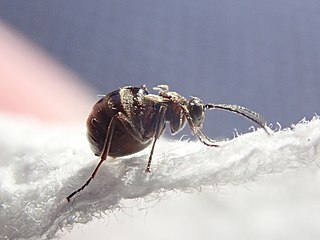
Dryocosmus are a genus of gall wasps. They are cyclically parthenogenetic insects that induce galls on plants in the family Fagaceae.

Andricus is a genus of oak gall wasps in the family Cynipidae.

Andricus dentimitratus is a gall forming wasp in the genus Andricus. The adults lay their eggs on various species of oak and the developing larvae causes the trees to create a large ornate gall. The oaks parasitised include Quercus frainetto, Q. petraea, Q. pyrenaica, Q. pubescens and Q. robur. The gall is formed out of the cup of the acorn. In cross-section it resembles a mushroom. It is woody, maroon, shiny and sticky. It grows up to 25 mm high and 20 mm wide. What resembles the head of the mushroom is lobed or toothed in various ways. The insect emerges from the narrowing, between the head and base.

Cynipini is a tribe of gall wasps. These insects induce galls in plants of the beech and oak family, Fagaceae. They are known commonly as the oak gall wasps. It is the largest cynipid tribe, with about 936 to 1000 recognized species, most of which are associated with oaks. The tribe is mainly native to the Holarctic.

Acraspis is a genus of gall wasps in the family Cynipidae. The following species are recognised in the genus Acraspis:
Pseudoneuroterus nichollsi is a gall wasp species in the family Cynipidae whose life cycle involves only Palaearctic oaks, Quercus subgen. Quercus, in the section Cerris.
Pseudoneuroterus mazandarani is a gall wasp species in the family Cynipidae whose life cycle involves only Palaearctic oaks, Quercus subgen. Quercus, in the section Cerris. The species is named for the Mazandaran province of Iran where it was collected. Gall wasps evolved in the Northern Hemisphere and started as herb gallers. Through natural selection they went through a period where they lost the ability to initiate galls and later regained it back. It is suggested the first gall wasps were associated with woody host plants.
Dryocosmus jungalii is a gall wasp species in the family Cynipidae whose life cycle involves only Palaearctic oaks, Quercus subgen. Quercus, in the section Cerris.
Aphelonyx kordestanica is a gall wasp species in the family Cynipidae whose life cycle involves only Palaearctic oaks, Quercus subgen. Quercus, in the section Cerris.
Aphelonyx is a genus of oak gall wasps in the family Cynipidae, comprising three known species:

Atrusca is a genus of gall wasps in the family Cynipidae. It consists of approximately 50 species, and is found in North and Central America.
Bassettia pallida is a species of gall wasp found in the Southern United States. This species was described by American entomologist William Harris Ashmead in 1896. B. pallida reproduces asexually in galls it induces on oak trees. The parasite Euderus set, a eulophid wasp, has B. pallida as a host and manipulates its behavior.
Synergini is a tribe of gall wasps in the subfamily Cynipinae.

Feron kingi, the red cone gall wasp, is a species of gall wasp in the family Cynipidae.
Synergus japonicus is a species of gall wasp in the family Cynipidae. Whereas most gall wasps create the galls in which they live, Synergus japonicus is an inquiline species, living in the gall created by another species of wasp. It is native to Japan, China and Russia.

Acraspis quercushirta, the jewel oak gall wasp, is a species of gall wasp in the family Cynipidae, tribe Cynipini, found in North America.

Kokkocynips is an American genus of gall wasps in the family Cynipidae. There are about 8 described species in the genus Kokkocynips with several others still undescribed.

Aphelonyx cerricola is a gall wasp species in the family Cynipidae which is native to Europe and Western Asia from Austria to Iran, and is an introduced species in Great Britain. Only the asexual generation is known, which induces galls on Quercus cerris within Europe with possible records on other species within Quercus section Cerris in Iran.

Besbicus is a genus of gall-inducing cynipid wasp found in North America. Several species now classed as Besbicus were formerly considered to be a part of the genus Cynips. Besbicus was originally described as a subgenus by Alfred Kinsey in 1929. Circa 2010, one group of entomologists noted that it was "possible that the nearctic genera Antron and Besbicus were erroneously synonymized to Cynips".

Dryocosmus castanopsidis, also known as the chinquapin flower gall wasp, is a species of cynipid wasp that induces galls on the flowers of giant chinquapin and bush chinquapin on the west coast of North America. The husk and flesh of the galls are red, with a "golden bloom" on the husk, and the central larval chamber has a green tint.














